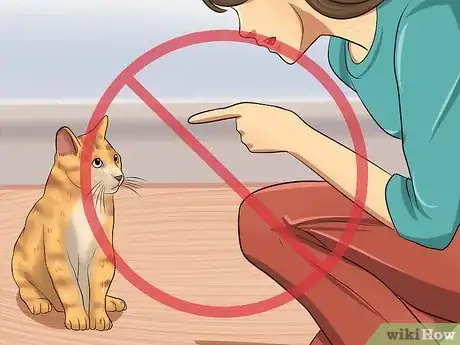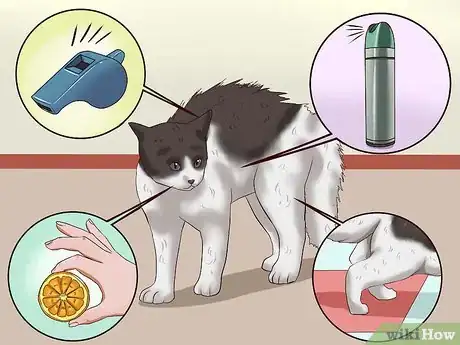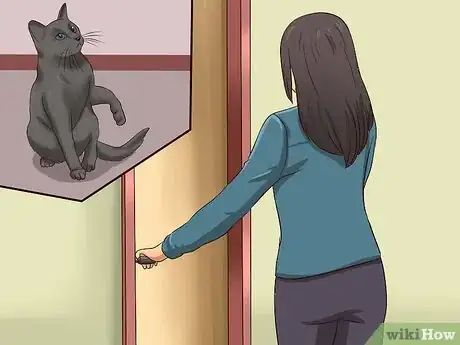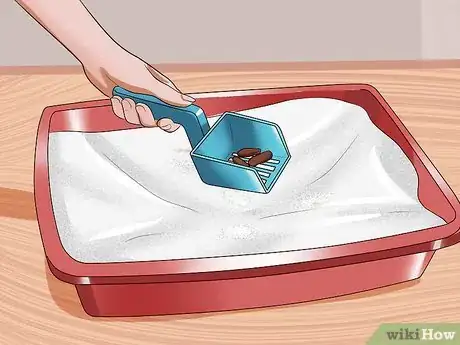This article was co-authored by Brian Bourquin, DVM. Brian Bourquin, better known as “Dr. B” to his clients, is a Veterinarian and the Owner of Boston Veterinary Clinic, a pet health care and veterinary clinic with three locations, South End/Bay Village, the Seaport, and Brookline, Massachusetts. Boston Veterinary Clinic specializes in primary veterinary care, including wellness and preventative care, sick and emergency care, soft-tissue surgery, dentistry. The clinic also provides specialty services in behavior, nutrition, and alternative pain management therapies using acupuncture, and therapeutic laser treatments. Boston Veterinary Clinic is an AAHA (American Animal Hospital Association) accredited hospital and Boston’s first Fear Free Certified Clinic. Brian has over 19 years of veterinary experience and earned his Doctor of Veterinary Medicine from Cornell University.
wikiHow marks an article as reader-approved once it receives enough positive feedback. This article has 19 testimonials from our readers, earning it our reader-approved status.
This article has been viewed 1,709,049 times.
You may love your cat more than anything in the world, but there are certain behaviors, such as tearing up furniture, scratching people, and getting into areas you don’t want her to access, that are simply unacceptable. You will need to practice patience and persistence to deter your cat’s bad behavior. With certain adjustments to her routine and the use of correcting techniques, you should be able to stop your cat from practicing bad behavior.
Steps
Determining the Cause of the Bad Behavior
-
1Understand the most common behavioral problems in cats. Though every cat is unique and may have specific issues or specific bad behaviors, most cats act out in seven ways:[1]
- Avoiding the litter box or refusing to use the litter box.
- Marking furniture and other objects with their urine.
- Scratching furniture and other objects in your home. Your cat may also scratch you or others when play fighting.
- Acting aggressive towards other people or towards their owner.
- Acting aggressive towards other cats in the home.
- Displaying stress or anxiety.
- Acting fearful of objects or people.
-
2Bring your cat to the vet for a checkup to rule out any medical issues. Sometimes cats will respond act out or display behavioral issues because they are struggling with a medical issue. For example, your cat may refuse to use his litter box due to a urinary tract infection, or he may act aggressively towards you because he is experiencing physical pain that is not immediately apparent to you. Some cats become fearful of people or objects due to vision issues and over groom themselves due to hyperthyroidism.[2]
- Taking your cat to the vet for a checkup will help identify any medical problems that could be causing your cat’s bad behavior and treat it promptly so it does not get worse. If your vet gives your cat a clean bill of health, you can focus on issues in your cat’s environment that may be causing his bad behavior.
Advertisement -
3Recognize any environmental causes for your cat’s bad behavior. Once your cat is cleared of any medical issues, you can consider why your cat might be displaying one or several of these bad behaviors. Look at his environment for any triggers of bad behavior, including:[3]
- A dirty or poorly kept litter box, which can lead to litter box avoidance.
- Another cat who is bullying your cat in the home, leading to litter box avoidance and aggression.
- A new cat in the home, which can cause your cat to urine mark. A new dog in the home can also cause your cat to act fearful or aggressive.
- A lack of scratching posts, which can lead to your cat scratching furniture and other objects in the home.
Correcting Your Cat’s Behavior
-
1Avoid physically or verbally punishing your cat. Physically or verbally reprimanding your cat is one of the least successful ways to correct your cat’s bad behavior. In fact, hitting your cat or yelling at him can lead your cat to act more fearful around you, be less willing to play with other people, and display more aggressive scratching and biting. Your cat will likely continue to act out when you are out of sight as he knows he can perform the behavior without punishment if you cannot see him.[4]
- Physical or verbal punishment is generally ineffective, as short-term solutions to your cat’s issues and will not stop your cat from acting out. Instead, it will create a more stressful environment for you and for your cat. Though it can be hard not to yell or hit your cat when they do something bad, like urine mark your furniture or go to the bathroom on the carpet instead of the litter box, it’s important that you take a deep breath as an owner and try to use a more effective correcting technique.
-
2Practice deterrence and positive reinforcement. Instead of punishing your cat, rather offer them a more preferable alternative to the object of their bad behaviour:[5]
- If your cat scratches your favourite couch or the side of your bed, it is probably because these items smell strongly like their favourite owner, and they are trying to mix their scent with yours. Deter this by placing a scratching post next to the area that they like to scratch. Scratching posts should be placed in 'social' areas in your house, where you spend a lot of your time. If they need some further encouragement, sprinkle some catnip onto the scratching post.
- Cats need at least one litter box per cat in the household. Litter boxes must be regularly cleaned. Failure to do so will result in cats going to the bathroom outside of the litter box, or fighting with one another due to increased tensions surrounding privacy - in a similar manner to siblings or couples who fight over bathroom time!
- DO NOT de-claw your cat. This is cruel, unnatural and will lead to a lifetime of pain and paw sensitivity for them. Instead, you can put sticky paper, aluminum foil, or heavy plastic carpet runners on areas that you would like your cat to avoid. This may be unsightly, but cats generally dislike walking on any of these textures.
- DO NOT attempt to deter a cat with smells, such as placing cloth or cotton balls soaked in citronella, perfume, air freshener, citrus, aloe, eucalyptus oil, and oil of wintergreen on objects or surfaces - this is irresponsible and can be extremely toxic to your cat. If you suspect that your cat has ingested or inhaled such substances, take them to the vet immediately.
- DO NOT attempt to deter a cat with tastes, such as placing certain foods on surfaces that your cat likes to chew on or scratch. These methods - such as bitter apple, citrus products, hot sauces, cayenne pepper, or aloe gel - can be toxic to your cat if they inhale or ingest it.
- Sound: Using noises that startle your cat can deter him from doing a behavior or going on a surface. However, loud sounds in close proximity, such as blowing a whistle, can damage their ears. Try to use clickers or a hand clap to startle them just as he is about to do something you consider bad behavior and he will come to associate the behavior with a negative sound.
-
3Ignore your cat when he acts out during a play session. If you notice your cat engaging in rough or aggressive play during a play session, you can try to correct this behavior by withdrawing your attention from them, or giving them a large stuffed toy to take their frustration out on. Sprinkle the toy with some catnip to calm them. [6]
- Do this by walking to another room and closing the door. Wait until he calms down before you touch him or address him. This will show him that his bad behavior is upsetting during playtime, and discourage him from acting out again.
EXPERT TIPBrian Bourquin, better known as “Dr. B” to his clients, is a Veterinarian and the Owner of Boston Veterinary Clinic, a pet health care and veterinary clinic with three locations, South End/Bay Village, the Seaport, and Brookline, Massachusetts. Boston Veterinary Clinic specializes in primary veterinary care, including wellness and preventative care, sick and emergency care, soft-tissue surgery, dentistry. The clinic also provides specialty services in behavior, nutrition, and alternative pain management therapies using acupuncture, and therapeutic laser treatments. Boston Veterinary Clinic is an AAHA (American Animal Hospital Association) accredited hospital and Boston’s first Fear Free Certified Clinic. Brian has over 19 years of veterinary experience and earned his Doctor of Veterinary Medicine from Cornell University.Cat Behavior Trainer
 Brian Bourquin, DVM
Brian Bourquin, DVM
Cat Behavior TrainerRemember to reward your cat for good behavior, as well. Cats can be taught to do almost anything—it's all about positive reinforcement. You almost never want to punish your cat. Instead, reward them when it does something that you like. That reward might be a treat, but it also might be as simple as a little scratch behind the ears.
Adjusting Your Cat’s Environment and Routine
-
1Practice good litter box hygiene. If your cat is displaying litter box avoidance, it’s important that you practice good litter box hygiene to encourage him to use the litter box. This means scooping and changing the litter every day, thoroughly washing the litter box once a week, and making sure the litter box is appealing to your cat. Most cats do not like litter boxes with hoods or liner, as it can be uncomfortable for them, so avoid using a litter box with a hood or a liner.[7]
- If there are multiple cats in your household, there should be a litter box for each cat, plus an extra litter box. Try to spread out the litter boxes so each cat has enough room and privacy to do their business. Look for a quiet area in the home where your cat can still look around and see if anyone is coming up behind her.
- Make sure the litter box is big enough for your cat to sit in comfortably and have one to two inches of litter in the box. Cats dislike litter boxes that are too deep with litter.
-
2Provide scratching posts and daily play sessions. Most cats act out due to boredom or under stimulation, so it is important that you commit to daily play sessions with your cat. Use a toy, or several toys, when playing with your cat to deter him from playing rough with your hands or arms. Focus his attention on the toys during the play sessions and switch up the toys each week so he does not get bored.[8]
- Scratching posts are also good for deterring your cat from scratching furniture or other fabric objects. Place scratching posts in communal areas of your home or your cat’s favorite spots.
-
3Use cat pheromones to reduce stress in the home. If your cat is urine marking or urine spraying, it can help to use a synthetic cat pheromone in the home. It can reduce stress and prevent your cat from urine marking if he is feeling anxious or fearful.[9]
- This pheromone is usually delivered through a diffuser or a spray and can be found at your local pet store.
Expert Q&A
-
QuestionDo cats learn if you punish them?
 Pippa Elliott, MRCVSDr. Elliott, BVMS, MRCVS is a veterinarian with over 30 years of experience in veterinary surgery and companion animal practice. She graduated from the University of Glasgow in 1987 with a degree in veterinary medicine and surgery. She has worked at the same animal clinic in her hometown for over 20 years.
Pippa Elliott, MRCVSDr. Elliott, BVMS, MRCVS is a veterinarian with over 30 years of experience in veterinary surgery and companion animal practice. She graduated from the University of Glasgow in 1987 with a degree in veterinary medicine and surgery. She has worked at the same animal clinic in her hometown for over 20 years.
Veterinarian No. Moreover, the cat will learn but not the lesson you intended to teach. Cats don't link "cause and effect," so if you punish a cat for jumping on a countertop, they don't link the punishment to the act but to you. What happens is the cat then learns to be fearful of you instead of learning to not jump up.
No. Moreover, the cat will learn but not the lesson you intended to teach. Cats don't link "cause and effect," so if you punish a cat for jumping on a countertop, they don't link the punishment to the act but to you. What happens is the cat then learns to be fearful of you instead of learning to not jump up. -
QuestionHow do you train a cat not to go outside?
 Pippa Elliott, MRCVSDr. Elliott, BVMS, MRCVS is a veterinarian with over 30 years of experience in veterinary surgery and companion animal practice. She graduated from the University of Glasgow in 1987 with a degree in veterinary medicine and surgery. She has worked at the same animal clinic in her hometown for over 20 years.
Pippa Elliott, MRCVSDr. Elliott, BVMS, MRCVS is a veterinarian with over 30 years of experience in veterinary surgery and companion animal practice. She graduated from the University of Glasgow in 1987 with a degree in veterinary medicine and surgery. She has worked at the same animal clinic in her hometown for over 20 years.
Veterinarian By making the indoors as attractive and fulfilling as possible, you can reduce the cat's urge to explore outdoors. Tactics include playing with the cat 2 - 3 times a day, providing puzzle feeders, and creating a kitty-friendly environment with high perches, kitty walkways, and safe basking spots on a catio or the like.
By making the indoors as attractive and fulfilling as possible, you can reduce the cat's urge to explore outdoors. Tactics include playing with the cat 2 - 3 times a day, providing puzzle feeders, and creating a kitty-friendly environment with high perches, kitty walkways, and safe basking spots on a catio or the like. -
QuestionHow do I train my cat not to scratch furniture?
 Pippa Elliott, MRCVSDr. Elliott, BVMS, MRCVS is a veterinarian with over 30 years of experience in veterinary surgery and companion animal practice. She graduated from the University of Glasgow in 1987 with a degree in veterinary medicine and surgery. She has worked at the same animal clinic in her hometown for over 20 years.
Pippa Elliott, MRCVSDr. Elliott, BVMS, MRCVS is a veterinarian with over 30 years of experience in veterinary surgery and companion animal practice. She graduated from the University of Glasgow in 1987 with a degree in veterinary medicine and surgery. She has worked at the same animal clinic in her hometown for over 20 years.
Veterinarian Cats need to scratch so the answer is to provide scratching posts the cat will enjoy using. Furniture scratching cats usually prefer vertical surfaces, so get several sturdy vertical scratch posts. It may help to cover them in a similar fabric to the furniture. Gently take kitty's paws and make scratching motions to transfer some of her scent. Praise kitty when she uses the posts.
Cats need to scratch so the answer is to provide scratching posts the cat will enjoy using. Furniture scratching cats usually prefer vertical surfaces, so get several sturdy vertical scratch posts. It may help to cover them in a similar fabric to the furniture. Gently take kitty's paws and make scratching motions to transfer some of her scent. Praise kitty when she uses the posts.
References
- ↑ http://www.catbehaviorassociates.com/the-must-have-checklist-for-solving-your-cats-behavior-problem/
- ↑ http://www.catbehaviorassociates.com/the-must-have-checklist-for-solving-your-cats-behavior-problem/
- ↑ http://www.catbehaviorassociates.com/the-must-have-checklist-for-solving-your-cats-behavior-problem/
- ↑ http://www.vcahospitals.com/main/pet-health-information/article/animal-health/undesirable-behavior-in-cats/197
- ↑ http://www.mspca.org/pet_resources/correcting-unwanted-cat-behavior/
- ↑ http://www.humanesociety.org/animals/cats/tips/kitten_play.html
- ↑ https://www.aspca.org/pet-care/virtual-pet-behaviorist/cat-behavior/litter-box-problems
- ↑ http://www.humanesociety.org/animals/cats/tips/kitten_play.html
- ↑ https://www.aspca.org/pet-care/virtual-pet-behaviorist/cat-behavior/urine-marking-cats
About This Article
To train a cat to stop doing almost anything, put a material with an unpleasant texture in the area you don't want your cat to go, like aluminum foil or double-sided tape. You can also spray the area with citronella, aloe, or citrus, which will deter your cat since it won't like the smell. If your cat misbehaves when it's stressed or hyperactive, try using a cat pheromone diffuser or spray, which will make it calmer so it's less likely to act out. For more tips, like how to use unpleasant tastes and sounds to stop your cat from misbehaving, read on!






































































